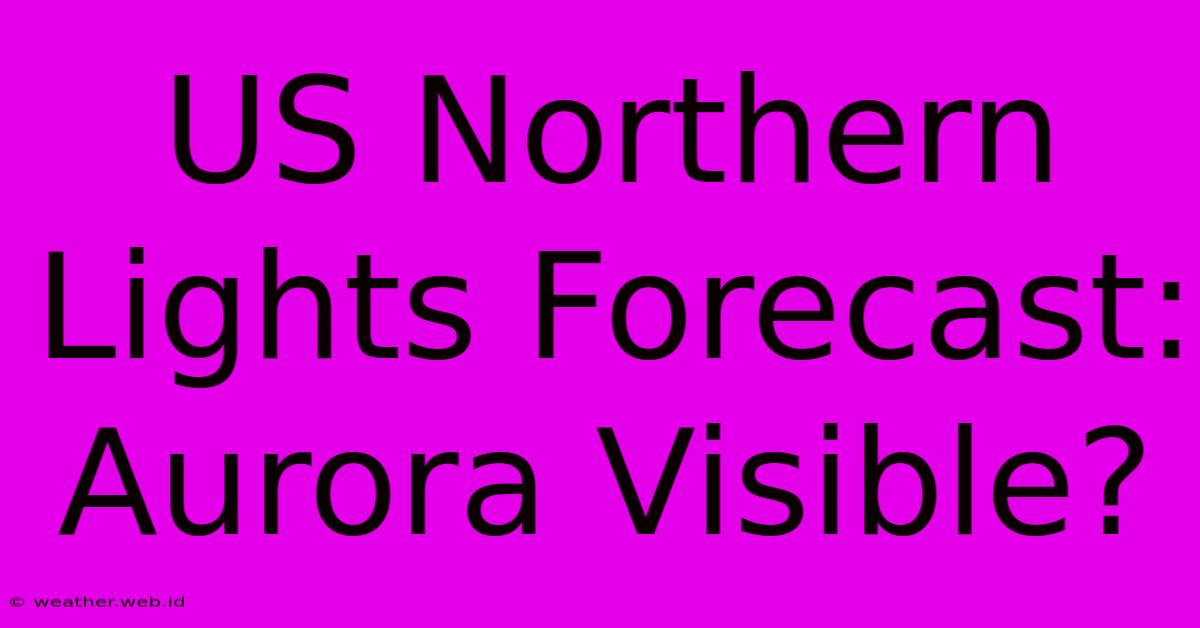US Northern Lights Forecast: Aurora Visible?

Discover more detailed and exciting information on our website. Click the link below to start your adventure: Visit Best Website weather.web.id. Don't miss out!
Table of Contents
US Northern Lights Forecast: Aurora Visible?
The shimmering curtains of the aurora borealis, or Northern Lights, are a breathtaking spectacle. While typically associated with high-latitude regions like Alaska and Canada, under the right conditions, these celestial displays can be visible even in the lower 48 United States. But when can you catch a glimpse of this natural wonder in the US? This article will guide you through understanding US Northern Lights forecasts and increase your chances of witnessing this magical event.
Understanding the Aurora Borealis
The aurora borealis occurs when charged particles from the sun, carried by the solar wind, interact with the Earth's atmosphere. These particles are channeled along the Earth's magnetic field lines, primarily towards the poles. The collision of these particles with atmospheric gases (oxygen and nitrogen) excites them, causing them to emit light – creating the stunning aurora displays.
Factors Affecting Aurora Visibility in the US
Several factors influence the visibility of the aurora in the US:
- Solar Activity: The intensity of the aurora is directly related to solar activity. Strong solar flares and coronal mass ejections (CMEs) increase the chances of seeing a vibrant aurora at lower latitudes. Space weather forecasts are crucial in predicting this.
- Geomagnetic Storms: These storms are disturbances in the Earth's magnetosphere caused by solar activity. Stronger geomagnetic storms (measured by the Kp index) push the aurora further south, increasing visibility in the US. A Kp index of 7 or higher often indicates potential aurora viewing in the northern US states.
- Light Pollution: Urban light pollution significantly reduces aurora visibility. To increase your chances, you need to find a dark location away from city lights.
- Weather Conditions: Clear skies are essential for aurora viewing. Cloud cover will completely obscure the aurora.
- Time of Year: The aurora is more visible during the winter months (October to March) when nights are longer and darker.
How to Check the US Northern Lights Forecast
Several resources provide forecasts for aurora activity:
- NOAA Space Weather Prediction Center: This is the official source for space weather forecasts in the US. They provide real-time data and predictions of geomagnetic storms, crucial for aurora viewing.
- Aurora Forecast Apps and Websites: Many dedicated apps and websites provide user-friendly aurora forecasts, often incorporating data from the NOAA and other sources. These often include visual forecasts showing the predicted aurora oval's position.
- Social Media: Aurora chasers often share real-time updates and photos on social media platforms like Twitter and Facebook. Following these communities can provide valuable insights and alerts.
Best Locations for Aurora Viewing in the US
While the aurora is most commonly seen in Alaska, under favorable conditions, you might see it further south. States like:
- North Dakota: Offers expansive dark skies and is often cited as a good location for aurora viewing in the lower 48.
- Montana: Similar to North Dakota, Montana possesses large areas with minimal light pollution.
- Minnesota: The northern parts of Minnesota, especially near the Canadian border, can sometimes witness aurora displays.
- Michigan: The Upper Peninsula of Michigan, with its dark skies, has reported aurora sightings.
- Maine: Northern Maine offers a chance, particularly in areas with minimal light pollution.
Remember that even with a strong forecast, visibility is not guaranteed. Be prepared for potential disappointment, but also for the possibility of a breathtaking celestial display.
Tips for Aurora Photography
If you're planning on photographing the aurora, here are some tips:
- Use a DSLR or Mirrorless Camera: These cameras offer more control over settings than smartphones.
- Tripod: Absolutely essential for long-exposure photography.
- Wide-Angle Lens: Captures more of the sky.
- High ISO: Increases sensitivity to light, but watch out for noise.
- Long Exposures: Capture the faint aurora light.
Witnessing the aurora borealis is an unforgettable experience. By understanding the factors affecting its visibility and utilizing the available forecast resources, you can significantly increase your chances of seeing this stunning natural phenomenon in the US.

Thank you for visiting our website wich cover about US Northern Lights Forecast: Aurora Visible?. We hope the information provided has been useful to you. Feel free to contact us if you have any questions or need further assistance. See you next time and dont miss to bookmark.
Featured Posts
-
2025 Winter Classic Bedards Game
Jan 01, 2025
-
Dallas Store Hours New Years Eve 2024
Jan 01, 2025
-
Live Blog Louisville Football At Sun Bowl
Jan 01, 2025
-
Nypd Woman Burned On Brooklyn Subway
Jan 01, 2025
-
Central Ny Snow Warning Wednesday Onward
Jan 01, 2025
